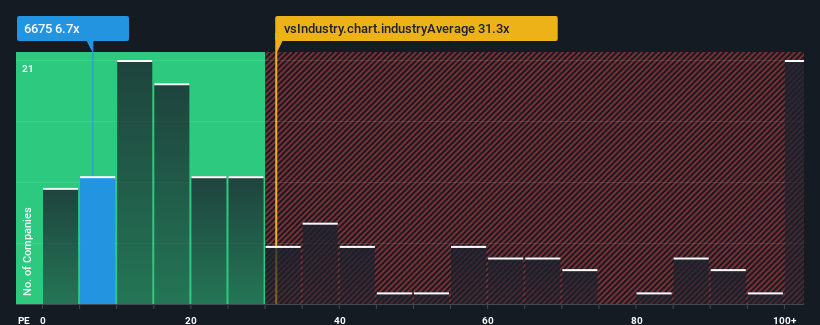- Japan
- /
- Communications
- /
- TSE:6675
Even With A 37% Surge, Cautious Investors Are Not Rewarding SAXA, Inc.'s (TSE:6675) Performance Completely
SAXA, Inc. (TSE:6675) shareholders have had their patience rewarded with a 37% share price jump in the last month. The last 30 days bring the annual gain to a very sharp 49%.
Although its price has surged higher, given about half the companies in Japan have price-to-earnings ratios (or "P/E's") above 14x, you may still consider SAXA as an attractive investment with its 6.7x P/E ratio. Nonetheless, we'd need to dig a little deeper to determine if there is a rational basis for the reduced P/E.
Our free stock report includes 2 warning signs investors should be aware of before investing in SAXA. Read for free now.SAXA has been doing a good job lately as it's been growing earnings at a solid pace. One possibility is that the P/E is low because investors think this respectable earnings growth might actually underperform the broader market in the near future. If that doesn't eventuate, then existing shareholders have reason to be optimistic about the future direction of the share price.
See our latest analysis for SAXA

What Are Growth Metrics Telling Us About The Low P/E?
In order to justify its P/E ratio, SAXA would need to produce sluggish growth that's trailing the market.
Retrospectively, the last year delivered an exceptional 26% gain to the company's bottom line. The strong recent performance means it was also able to grow EPS by 192% in total over the last three years. Accordingly, shareholders would have probably welcomed those medium-term rates of earnings growth.
Comparing that to the market, which is only predicted to deliver 9.6% growth in the next 12 months, the company's momentum is stronger based on recent medium-term annualised earnings results.
With this information, we find it odd that SAXA is trading at a P/E lower than the market. Apparently some shareholders believe the recent performance has exceeded its limits and have been accepting significantly lower selling prices.
What We Can Learn From SAXA's P/E?
Despite SAXA's shares building up a head of steam, its P/E still lags most other companies. It's argued the price-to-earnings ratio is an inferior measure of value within certain industries, but it can be a powerful business sentiment indicator.
We've established that SAXA currently trades on a much lower than expected P/E since its recent three-year growth is higher than the wider market forecast. When we see strong earnings with faster-than-market growth, we assume potential risks are what might be placing significant pressure on the P/E ratio. It appears many are indeed anticipating earnings instability, because the persistence of these recent medium-term conditions would normally provide a boost to the share price.
There are also other vital risk factors to consider before investing and we've discovered 2 warning signs for SAXA that you should be aware of.
If you're unsure about the strength of SAXA's business, why not explore our interactive list of stocks with solid business fundamentals for some other companies you may have missed.
New: Manage All Your Stock Portfolios in One Place
We've created the ultimate portfolio companion for stock investors, and it's free.
• Connect an unlimited number of Portfolios and see your total in one currency
• Be alerted to new Warning Signs or Risks via email or mobile
• Track the Fair Value of your stocks
Have feedback on this article? Concerned about the content? Get in touch with us directly. Alternatively, email editorial-team (at) simplywallst.com.
This article by Simply Wall St is general in nature. We provide commentary based on historical data and analyst forecasts only using an unbiased methodology and our articles are not intended to be financial advice. It does not constitute a recommendation to buy or sell any stock, and does not take account of your objectives, or your financial situation. We aim to bring you long-term focused analysis driven by fundamental data. Note that our analysis may not factor in the latest price-sensitive company announcements or qualitative material. Simply Wall St has no position in any stocks mentioned.
About TSE:6675
SAXA
Through its subsidiaries, develops, manufactures, and sells equipment and components for information and communication systems in Japan.
Flawless balance sheet, undervalued and pays a dividend.
Market Insights
Community Narratives



